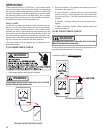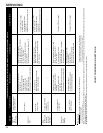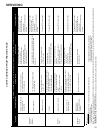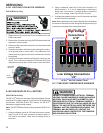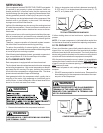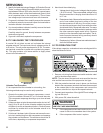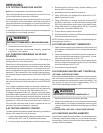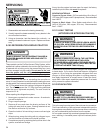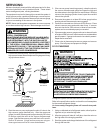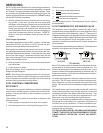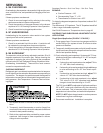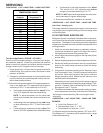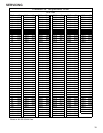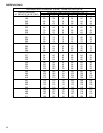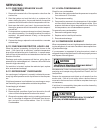
SERVICING
34
WARNING
1. Disassemble and remove the heating element(s).
2. Visually inspect the heater assembly for any breaks in the
wire or broken insulators.
3. Using an ohmmeter, test the element for continuity - no
reading indicates the element is open. Replace as neces-
sary.
S-100 REFRIGERATION REPAIR PRACTICE
DANGER
ALWAYS REMOVE THE REFRIGERANT CHARGE IN
A PROPER MANNER BEFORE APPLYING HEAT TO
THE SYSTEM.
These models use the FasTest Access Fitting System, with a
saddle that is either soldered to the suction and liquid lines or
is fastened with a locking nut to the access fitting box (core)
and then screwed into the saddle. Do not remove the core
from the saddle until the refrigerant charge has been
removed. Failure to do so could result in property dam-
age or personal injury.
When installing a new core or reinstalling the core after re-
moval, it is very important to note that before inserting the core
into the saddle, the core and saddle must be free of debris and
the “O” Ring must have a thin coating of refrigerant oil applied
to it. The oil is to prevent the “O” Ring from being deformed
when the core is tightened completely. The core should be
torqued to 8 ft. lb.
When repairing the refrigeration system:
1. Never open a system that is under vacuum. Air and mois-
ture will be drawn in.
2. Plug or cap all openings.
3. Remove all burrs and clean the brazing surfaces of the
tubing with sand cloth or paper. Brazing materials do not
flow well on oxidized or oily surfaces.
4. Clean the inside of all new tubing to remove oils and pipe
chips.
5. When brazing, sweep the tubing with dry nitrogen to pre-
vent the formation of oxides on the inside surfaces.
6. Complete any repair by replacing the liquid line drier in the
system, evacuate and charge.
At any time the system has been open for repair, the factory
installed liquid line filter drier
must be replaced.
BRAZING MATERIALS
Copper to Copper Joints - Sil-Fos used without flux (alloy of
15% silver, 80% copper, and 5% phosphorous). Recommended
heat 1400°F.
Copper to Steel Joints - Silver Solder used without a flux
(alloy of 30% silver, 38% copper, 32% zinc). Recommended
heat - 1200°F.
S-101 LEAK TESTING
(NITROGEN OR NITROGEN-TRACED)
WARNING
TO AVOID THE RISK OF FIRE OR EXPLOSION, NEVER
USE OXYGEN, HIGH PRESSURE AIR OR FLAMMABLE
GASES FOR LEAK TESTING OF A REFRIGERATION
SYSTEM.
WARNING
TO AVOID POSSIBLE EXPLOSION, THE LINE FROM
THE NITROGEN CYLINDER MUST INCLUDE A
PRESSURE REGULATOR AND A PRESSURE RELIEF
V
ALVE. THE PRESSURE RELIEF VALVE MUST BE SET
TO OPEN AT NO MORE THAN 150 psig.
Pressure test the system using dry nitrogen and soapy water
to locate leaks. If you wish to use a leak detector, charge the
system to 10 psi using the appropriate refrigerant then use
nitrogen to finish charging the system to working pressure,
then apply the detector to suspect areas. If leaks are found,
repair them. After repair, repeat the pressure test. If no leaks
exist, proceed to system evacuation.
S-102 EVACUATION
WARNING
REFRIGERANT UNDER PRESSURE!
FAILURE TO FOLLOW PROPER PROCEDURES MAY
CAUSE PROPERTY DAMAGE, PERSONAL INJURY OR
DEATH.
This is the most important part of the entire service procedure.
The life and efficiency of the equipment is dependent upon the
thoroughness exercised by the serviceman when evacuating
air (non-condensable) and moisture from the system.
Air in a system causes high condensing temperature and pres-
sure, resulting in increased power input and reduced perfor-
mance.



